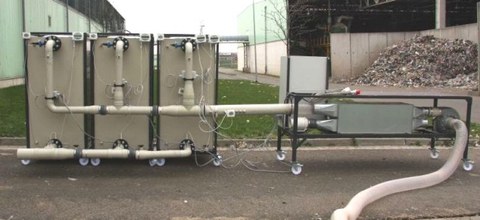research project SILOXANE II
Transfer from in-house to standard methodology of the measurement procedure for the determination of organosilicon compounds; development of a measurement method for the determination of total silicon content in exhaust, bio- and landfill gases; further development of pilot-scale biofilters for the reduction of silicon content in the exhaust gas of mechanical biological treatment plants (Siloxane II)
| Partner: | MATTERSTEIG & Co. Ingenieurgesellschaft für Verfahrenstechnik und Umweltschutz mbH |
| Funding: | Sächsische Aufbaubank (SAB) |
| Duration: | November 2010 - September 2013 |
| Contact: | Dr.-Ing. Stephan Mattersteig |
project description:
Organosilicon compounds are nowadays used in many products of the daily life; consequently these compounds are present in waste. To ensure compliance with the German emission limits of total organic carbon and odour, post-combustion plants with pre-heating (RTO) are commonly used in mechanical-biological treatment plants (MBTs). During the process of mechanical-biological waste treatment, volatile methyl-siloxanes (VMSs) are generated and/or released into the exhaust gas. Through the combustion of exhaust air in RTO, VMSs are oxidizing to silicon dioxide in the combustion chamber, which blocks the heat exchangers’ surface and thus lowers the efficiency of RTO in terms of heat transmission and gas flow rate. Because of the high amount of exhaust gas a total blocking of the heat exchanger can occur after a few weeks and can be regenerated only by a cost intensive cleaning or replacement of the ceramic stones the heat exchanger consists of. Organosilicon compounds are responsible for short operation times of the RTO and high running costs up to 2.50 €/Mg input
Until now there are no cost-effective solutions available for this problem.
Objectives:
The research is focused on the development of a cost effective gas treatment strategy for VMSs in MBTs. Parts of the research are the development of a consistent sampling and analysing method for VMSs, investigations on siloxanes release during mechanical-biological waste treatment to get knowledge of involved VMSs species, emission sources and gas concentrations dependent on the progress of the rotting, input materials and process conditions and investigations on biological filtering as a possible gas treatment option.
Investigations:
Two comprehensive measurement series on VMSs release during the intensive rotting were done at Germany’s largest MBT plant Cröbern over 6 weeks each as well as measurements on other types of MBTs in Germany and Austria, landfills, biogas plants and sewage plants. After indicative measurements in a technical biofilter of an Austrian MBT indicated VMSs reduction in MBT exhaust gas, investigations concentrated on biofilters to study this process. Next to quarterly measurements at the technical biofilter in Austria, two biofilter test facilities were operated over 7 months and 10 months. In addition retention experiments with fermenter grown bacteria were done. The VMSs retention in samples with active and inactivated bacteria compared to reference samples should indicate whether bacterial cells are involved in the VMSs reduction effects observed in biofilters.
Results:
The investigations on VMSs release showed that the main emission of VMSs take place during the first days of the rotting process, higher VMSs concentrations occur in case of low oxygen content, age and composition of the input rotting material influence VMSs release and the cyclic VMS D5 represents constantly the main part of VMSs emission during intensive rotting. The investigations on biofilters show VMSs reduction up to 80% but stable biofilter performance apparently depends on process conditions, which need further research. It is furthermore not clear if the VMSs reduction bases on microbial, chemical or/and physical effects. Retention experiments with microorganisms indicate that bacteria most likely contribute to the process of VMSs reduction. The metabolic activity of the cells seems to play a role but microbial degradation is implausible. Future research should explain the unspecific VMSs retention by biofilters or rather bacterial cells.


